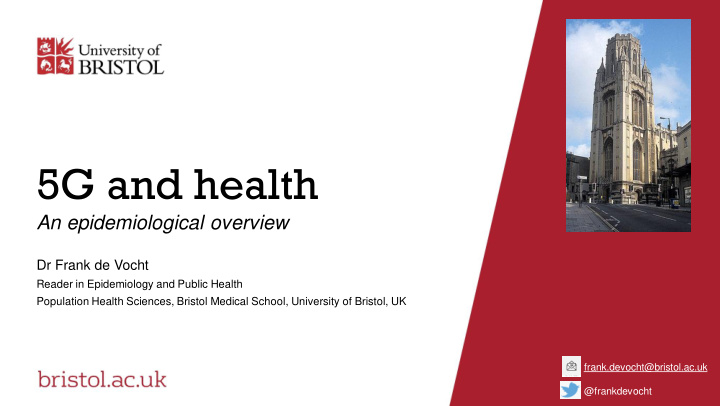



5G and health An epidemiological overview Dr Frank de Vocht Reader in Epidemiology and Public Health Population Health Sciences, Bristol Medical School, University of Bristol, UK frank.devocht@bristol.ac.uk @frankdevocht
5G and epidemiology: general concepts Studies in ICNIRP* human guidelines populations Non-Thermal Thermal effects effects 3G-4G (6Ghz -) 5G Millimeter waves Limited data (26 Ghz+) but we can make reasonable inferences * International Commission on Non-Ionizing Radiation Protection (ICNIRP)
An overview of RFR and health outcomes ▪ Cancer ▪ Fertility ▪ Birth outcomes ▪ Development and behaviour ▪ Immune system ▪ Electrohypersensitivity + the likely contribution of 5G GHz spectrum
Cancer ▪ To date no conclusive evidence that RFR causes cancer ▪ Indirect biological mechanisms proposed, but none sufficiently backed up by data or are convincing ▪ WHO- IARC classified RFR as ‘possibly carcinogenic to humans’ (Group 2B) in 2011 ▪ Incidence trends do not confirm associations with RFR (despite some increasing trends) ▪ Small excess risk for very heavy users cannot be completely excluded, but increasingly unlikely RFR is an important cancer risk factor ▪ New studies in rats and mice (the ‘NTP’ and ‘ Rammazzini ’ studies) suggest increased risks of glioma and schwannoma, but problems with interpretation of these results ▪ 5G is unlikely to change that conclusion ▪ Mm waves will not penetrate far into human bodies, making additional contribution to cancers unlikely ▪ Possible (but not probable) exceptions are skin and ocular cancers
Fertility ▪ Evidence mainly from studies in cells and animals ▪ Human studies generally small, susceptible to biases and not representative of general population (mostly couples attending fertility clinics) ▪ Decline in sperm count since 1970s, especially in industrialised world, implies RFR, together with other potential environmental exposures, cannot be conclusively excluded ▪ No established non-thermal mechanism by which RFR could affect male fertility ▪ Sperm development sensitive to heat, and carrying a phone in trouser pocket carries a theoretical hazard (little evidence of risk) ▪ Potentially higher frequencies in 5G could result in sufficient heating of testicular tissue
Birth outcomes ▪ Results from animal studies inconsistent, but some showed effect on birth weight ▪ Human population studies suggest small effect on reducing pregnancy duration (could result in preterm birth), but not fetal growth or birth weight ▪ However, methodological issues of residual confounding (maternal stress) and weak exposure assessment ▪ Mathematical modelling indicates RFR exposure to fetus very low ▪ Implausible that 5G millimeter waves will change this
Development, cognition and behaviour ▪ Hyperactivity, behavioural problems, and effects on cognition associated with RFR in utero or during childhood reported ▪ Experimental data (adults) show cognition can be affected (positive and negative), and effects disappear after exposure has ended ▪ However, unclear whether effects caused by RFR or persistent use of mobile devices (sleep problems, concentration problems, depression) ▪ Associations with Alzheimer’s disease and dementia suggested, but little evidence for this ▪ Causal relations cannot be excluded, but little concern that 5G can exacerbate this
Immune system ▪ Some in vitro and in vivo (few in humans) studies report effects (positive and negative) on immune system parameters ▪ Evidence mostly from small studies that have not been replicated, many with significant design issues ▪ No evidence of a relationship with health in human population ▪ No evidence or plausible theories how 5G mm-waves could directly impact on health via immune system ▪ Various indirect biological mechanisms proposed, but none sufficiently backed up by data or are convincing ▪ Nonetheless, this is the basis for the 5G/COVID-19 conspiracy theory, for example
Electrohypersensitivity Idiopathic Environmental Intolerance attributed to Electromagnetic Fields (IEI-EMF) ▪ 1%-10% of the population self-diagnoses as suffering from IEI-EMF ▪ Remains unclear whether IEI-EMF should be attributed to – electromagnetic radiation – entirely psychosomatic – combination of both ▪ Conceivable some people may be more susceptible to radiation ▪ 5G: visible small cell networks and knowledge of MIMO technology likely to create obvious, and regular, triggers for nocebo effects
Summary 3-4G ▪ Cancer risk: Increasingly unlikely RFR is an important factor ▪ Fertility and birth outcomes: associations plausibly result from study weaknesses or other exposures ▪ Development, cognition and behaviour: Weak evidence associations, possibly attributed to excessive use instead ▪ Immune system: Possible immune parameter responses, but no evidence this results in human health effects 5G ▪ Exposure – <3Ghz environmental exposure similar or lower than 2-4G, so unlikely 5G will result in increased health risks – Mm-waves unlikely to exacerbate effects in humans ▪ Remain gaps in research in human populations for 3 Ghz+ ▪ Areas of attention are cancers of the skin and eye, and possibilities of local heating (in particular testicular tissue) ▪ Roll-out of 5G will impact on EHS sufferers, regardless of aetiological mechanism
Take home messages RFR can result in biological responses i. …but evidence for health effects in humans in “real life” less convincing ii. In any case, if there are health effects, the fact they are so difficult to iii. establish implies individual risks are small (at most) Ultimate answer is human observational studies iv.
Dr Frank de Vocht Reader in Epidemiology and Public Health Population Health Sciences, Bristol Medical School, University of Bristol, UK frank.devocht@bristol.ac.uk @frankdevocht Links of interest (for info, without endorsements) • 5G Health Fears: An Epidemiological Approach . Cambridge Wireless Journal Nov 2019. https://flickread.com/edition/html/5dc345f09c736#10 • Scientific Committee on Emerging and Newly Identified Health Risks (SCENIHR) Report https://ec.europa.eu/health/scientific_committees/emerging/docs/scenihr_o_041.pdf • IARC Monographs on the Evaluation of Carcinogenic Risks to Humans Volume 102. Non-ionizing Radiation, Part 2: Radiofrequency Electromagnetic Fields: https://publications.iarc.fr/_publications/media/download/3143/6464cac7e8eca3fa20f11d4d134613e4870158c5.pdf • ICNIRP Guidelines (100 KHz to 300 GHz): https://www.icnirp.org/cms/upload/publications/ICNIRPrfgdl2020.pdf • BioInitiative Report : https://bioinitiative.org/
Recommend
More recommend